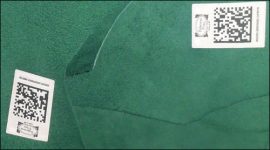
Poltrona Frau uses RFID technology to track leather materials
[ad_1]
Poltrona Frau, a luxury leather furniture manufacturer, started using RFID systems to reduce the time and error probability in the process of receiving leather upholstery materials and to carry out inventory counts in its own warehouses and third-party warehouses.
Poltrona Frau produces high-quality leather products mainly for customers in 3 sectors (residential, interior, custom furniture). Residential products include sofas, chairs, tables, etc.; in-car products include leather seats for cars, aircraft, and yachts; custom furniture is customized leather products for auditoriums, theaters, leisure clubs, museums, hotels, resorts and other companies.

The company’s suppliers need to customize the leather material for the company and transport it to the company’s manufacturing plant in the central Italian city of Tolentino. Every year, the company consumes 300,000 sheets of leather material of different sizes, colors and types.
Poltrona Frau always stocks various types of leather at the factory. The company will start production after receiving the order to ensure that the leather on each piece of furniture can be perfectly matched. The production process for each piece of furniture takes several weeks, so Poltrona Frau’s product delivery time is 4 weeks. If the company’s factory does not have a specific type of leather material, the company needs to urgently procure it from the supplier; the production process of leather takes up to 6 weeks, which will cause delayed arrival.
Therefore, the company needs to ensure that there is no shortage of leather in the inventory. Before the RFID system was installed, when new materials were received, employees had to manually check the material types on the pallets and enter the data into the company’s ERP system.
When the company needs leather, employees need to find it from the warehouse and update the data on the ERP. Due to the time-consuming process, the company only conducts 2 stocktakings per year. Poltrona Frau also needs to send employees to a nearby third-party warehouse for inventory. Typically, a company needs seven employees to spend 10 days per year doing inventory counts. This process is not only time-consuming, but also prone to errors.
This year the company began deploying an RFID system provided by Aton. Aton company manager Denisa Zara said, Aton also provides process analysis, software development, hardware integration and after-sales support.
“The complexity of the process is the biggest challenge,” says Zara. “We had to take into account not only the Poltrona Frau process and systems, but also the tannery.” To develop this solution, Aton used heuristics rather than traditional algorithms.
Identifying the optimal placement of the labels (to better accommodate the leather cutting process) is another challenge, according to Zara.
Poltrona Frau started using RFID solutions on residential products. This summer, the company first used RFID tags on leather from three suppliers. The company attaches a label to the inside edge of the leather, which reduces damage to the leather and does not appear on the furniture (leather edges are cut).
Suppliers need to use their own software to enter leather-related information: ID, item code, color, batch number and production time. These data will be bound to RFID tags. The supplier then sends this information to Poltrona Frau in the form of an Advance Shipment Notice.
After Poltrona Frau receives this notification, Aton’s RFID software will store these tags’ ID numbers and other information. When the leather arrives at the warehouse, employees don’t need to manually check it, they just use the MC9190-Z handheld reader to read it, the data will be automatically uploaded into the ERP software, and the status will be updated as received. The Aton software will also issue a warning when the reader detects that an item is missing or that other types of material have been received.
Using RFID technology, the receipt time of each pallet is only 15 minutes. When a factory needs a specific leather to produce, employees simply look for it with the reader. Employees can also manually scan the barcode printed on the RFID tag if the tag cannot be read.
The company can’t give a time frame because a full inventory count has not yet been conducted using the technology. The company estimates that using the system will only take one or two employees a day.
In this way, the company can carry out inventory counts more often to ensure inventory accuracy, thereby preventing material shortages.
All residential product materials will be marked by the end of the year, the company said. Next year, the program will be used in automotive products. Boselli said the system could also be used to track other furniture materials, such as wood.
(The exclusive manuscript of rfid world network, please indicate the source author for reprinting!)
[ad_2]



